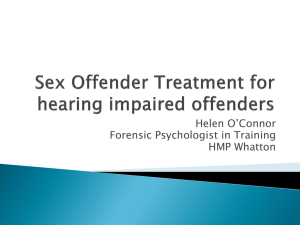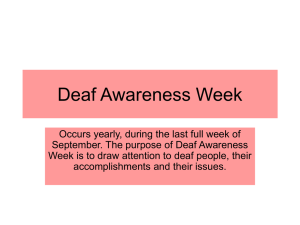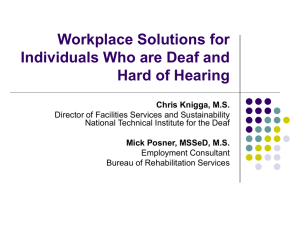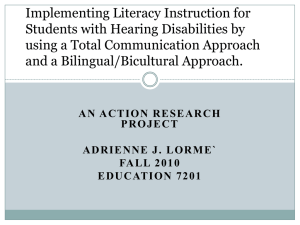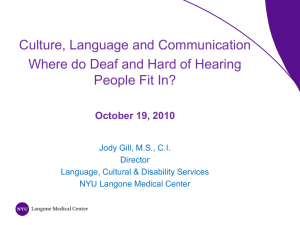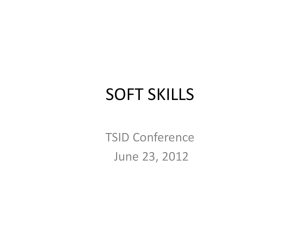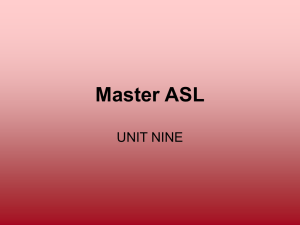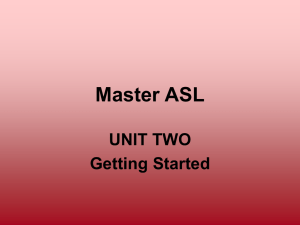Deaf Culture Pretest - AMERICAN SIGN LANGUAGE
advertisement
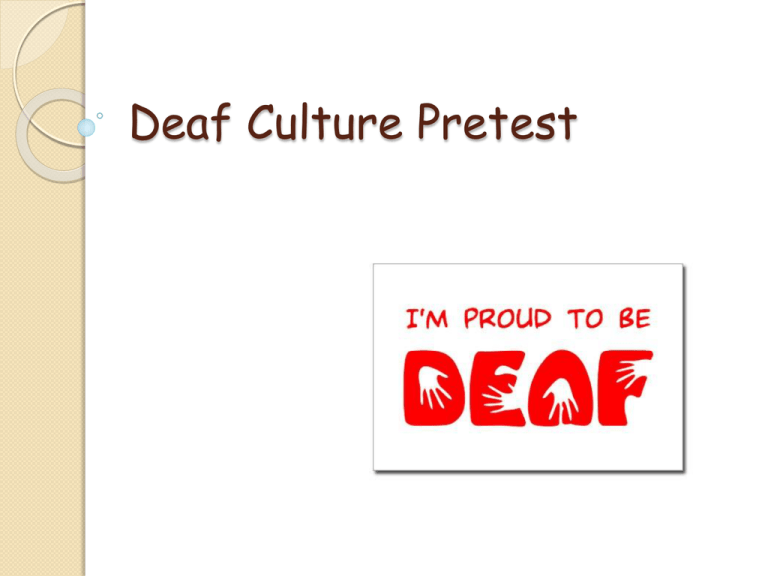
Deaf Culture Pretest What does ASL stand for?? ASL is short for American Sign Language Those who are familiar with this acronym almost always primarily only say ASL when referring to American Sign Language. Those who are fluent in this language take pride in using the term A S L ASL is not = English ASL is historically related to French Sign Language The first Deaf American Sign Language teacher came from France. Is American Sign Language (ASL) Universal? According to the World Federation of the Deaf: There are about 70 million deaf people who use sign language as their first language. Each country has one or sometimes two or more sign languages Examples of Various Sign Languages There are at least 25 sign languages in Africa British Sign Language (BSL) Japanese Sign Language (NS) and MANY MORE across the globe. American Sign Language is closely related to French Sign Language, because of the “fathers of ASL” Laurent Clerc and Thomas Gallaudet. Reading Level Stats for Deaf Adults An average reading level of 3rd grade is typical of graduates of deaf education programs in the U.S. 45% of deaf individuals do not graduate from high school and only 5% graduate from college. Lipreading In general, it is the least effective communication strategy. Only approximately 30% of speech is visible on the lips http://www.youtube.com/watch?v= QlwilbVYvUg The American with Disabilities Act A benchmark law was signed by President George H.W. Bush in 1990 called the American with Disabilities Act (ADA) Under Title II of the ADA, all state and local governments are required to take steps to ensure that their communications with people with disabilities are as effective as communications with others. Simply put, “effective communication” means that whatever is written or spoken must be as clear and understandable to people with disabilities as it is for people who do not have disabilities. Interpreters and the ADA Under the guidelines of effective communication, state and local government must provide auxiliary aids, such as interpreters to Deaf and Hard-of-Hearing persons. Can I take my interpreter home??? Unfortunately, Deaf people aren’t provided an interpreter for home and personal use. The interpreter is only provided when the Deaf or Hard-of-Hearing person is receiving services provided by the state or local government. Examples include: ◦ Court ◦ School Can Deaf People Drive??? Deaf people are legally allowed to drive in the United States They are taught how to drive the same way, but they learn how to do it visually According a study conducted in New Zealand, out of 30,000 accidents, not one was directly related to hearing loss. Michigan School for the Deaf Founded in 1848 Located in Flint, Michigan Currently has approximately 150 students Service grades K-12 Always rumored to be closed. Over the past 15 years 5 state schools for the deaf have closed across the United States. Others have experienced reduced enrollment and funding. TDD Telecommunication Device for the Deaf (TDD): an electronic device for text communication over a telephone line This is a very dated form of technology. Video Relay Service Is a videocommunication service that allows deaf and hard-of-hearing individuals to communicate over video telephones and similar technologies with hearing people in real-time via a sign language interpreter. Major Video Relay Companies include: Sorenson, Purple, and Power. Deaf-Mute Deaf means the inability to hear. Mute means the inability to speak. MOST DEAF PEOPLE ARE NOT MUTE Deaf-mute used to be an acceptable term, but is now viewed as an insulting term. Cochlear Implant A cochlear implant is a small, complex electronic device that can help to provide a sense of sound to a person who is profoundly deaf or severely hard-ofhearing. An implant does not restore normal hearing. Instead, it can give a deaf person a useful representation of sounds in the environment and help him or her to understand speech. http://www.youtube.com/watch?v=SpKKYB kJ9Hw “Fixing” Deaf people Many hearing people assume that deaf people want to be able to hear and encourage them to get cochlear implants. Deaf people do not view being deaf as a disability and do not feel they need to be fixed. The first Deaf president of Gallaudet University was quoted as saying, “Deaf people can do everything but hear.” Deaf people take pride in the language, community and their culture. Deaf Person’s Interpreter Act Signed into law in 2007 in the State of Michigan. Requires that deaf people be provided with a “Qualified interpreter” "Qualified interpreter" means a person who is certified through the national registry of interpreters for the deaf or certified through the state by the division. Interpreting Programs ASL is a very complex language and one cannot effectively interpret after taking 3 entry level classes. Madonna University has a Sign Language Studies program, which requires students to take and pass over 80 credit hours. Conclusion This is just a glimpse into an amazing culture, language, and group of people. There’s so much more to learn!!!
